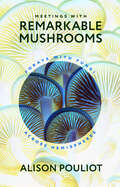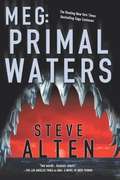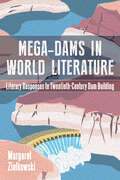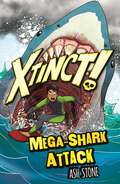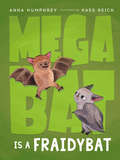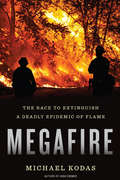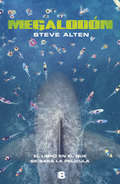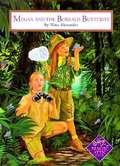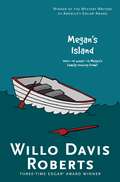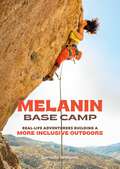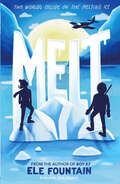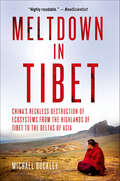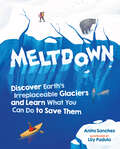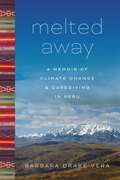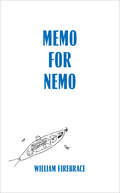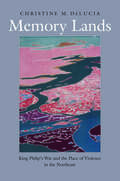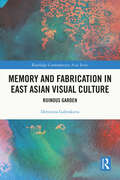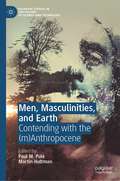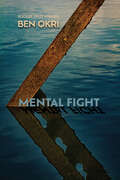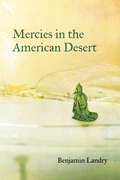- Table View
- List View
Meetings with Remarkable Mushrooms: Forays with Fungi across Hemispheres
by Alison PouliotA whirlwind journey through fungus frontiers that underscores how appreciating fungi is key to understanding our planet’s power and fragility.What can we learn from the lives of fungi? Splitting time between the northern and southern hemispheres, ecologist Alison Pouliot ensures that she experiences two autumns per year in the pursuit of fungi—from Australia’s deserts to Iceland’s glaciers to America’s Cascade Mountains. In Meetings with Remarkable Mushrooms, we journey alongside Pouliot, magnifiers in hand, as she travels the world.With Pouliot as our guide, we smell fire-loving truffles that transform their scent after burning to lure mammals who eat them and, ultimately, spread their spores. We spot the eerie glow of the ghost fungus, a deceptive entity that looks like an edible oyster mushroom but will soon heave back out—along with everything else in your stomach—if you take a bite. And we crawl alongside vegetable caterpillars, which are neither vegetable nor caterpillar but a fungus that devours insects from the inside out.Featuring stunning color photographs of these mycological miracles, Meetings with Remarkable Mushrooms shows that understanding fungi is fundamental for harmonizing with the natural world.
Meg: Primal Waters
by Steve AltenEighteen years have passed since Angel, the Megalodon shark, broke free of the Tanaka Lagoon and returned to the Mariana Trench. Jonas Taylor, adventurer, has become Jonas Taylor, middle-aged father of two, overwhelmed by a mountain of bills and the daily strife of raising a family. But life is about to change. A Hollywood television producer wants Jonas to join his new survival series, Daredevils. For the next six weeks, two teams of crazy daredevils on a South Pacific Ocean voyage, aboard a replica of a Spanish galleon, will try to outperform one another in front of the cameras. Jonas needs the money, and the job seems easy enough--doing color commentary. But behind the scenes, someone else is pulling the strings. And before it's over, Jonas, Terry, and Mac will again come face to face with the most dangerous creature ever to stalk the Earth.
Mega-Dams in World Literature: Literary Responses to Twentieth-Century Dam Building
by Margaret ZiolkowskiMega-Dams in World Literature reveals the varied effects of large dams on people and their environments as expressed in literary works, focusing on the shifting attitudes toward large dams that emerged over the course of the twentieth century. Margaret Ziolkowski covers the enthusiasm for large-dam construction that took place during the mid-twentieth-century heyday of mega-dams, the increasing number of people displaced by dams, the troubling environmental effects they incur, and the types of destruction and protest to which they may be subject. Using North American, Native American, Russian, Egyptian, Indian, and Chinese novels and poems, Ziolkowski explores the supposed progress that these structures bring. The book asks how the human urge to exploit and control waterways has affected our relationships to nature and the environment and argues that the high modernism of the twentieth century, along with its preoccupation with development, casts the hydroelectric dam as a central symbol of domination over nature and the power of the nation state. Beyond examining the exultation of large dams as symbols of progress, Mega-Dams in World Literature takes a broad international and cultural approach that humanizes and personalizes the major issues associated with large dams through nuanced analyses, paying particular attention to issues engendered by high modernism and settler colonialism. Both general and specialist readers interested in human-environment relationships will enjoy this prescient book.
Mega-Shark Attack: Book 3 (Xtinct! #3)
by Ash StoneA Megaladon Shark comes back to life in this action-packed adventure story. When Jeevan gets caught in one of Barron Fox's fishing nets, he is pulled into a dangerous underwater adventure. But drowning is the least of his worries. An extinct animal has come back to life in the water ... a megaladon shark! Can Jeevan escape the jaws of the mega-shark and outwit Barron Fox's hunters?Perfect for fans of Beast Quest, Deadly 60 and Jurassic Park, these action-packed adventures will inspire readers to help save endangered species and combat extinction.
Megabat Is a Fraidybat (Megabat #3)
by Anna HumphreyMegabat and his best friend, Daniel, go to sleepaway camp for the first time. Another hilarious chapter book in this laugh-out-loud series for fans of Dory Fantasmagory and Narwhal and Jelly.Daniel is not so sure about going to camp. There will be bugs. And uncomfortable beds. And leeches!Megabat can't WAIT to go to camp! There will be so much smooshfruit, and he loves a good sing-along. Daniel starts to think camp isn't so bad. He's made friends, and his bed isn't THAT uncomfortable.Megabat has made a new friend too. But his new friend wants him to go flying to spooky caves. And her mom is very toothy. As Daniel is getting into the swing of things and starting to enjoy camp, Megabat is getting himself into one tangle after another to avoid going into the scary woods. But can Megabat overcome his fears to help save his new friend? Kass Reich's adorable illustrations paired with Anna Humphrey's hilarious text make for another unforgettable Megabat adventure, one that will appeal to Megabat fans and newcomers!
Megafire: The Race to Extinguish a Deadly Epidemic of Flame
by Michael KodasThis bestselling author of High Crimes explores what causes forest fires and captures their danger and the heroism of those who fight them.In Megafire, a world-renowned journalist and forest fire expert travels to dangerous and remote wildernesses, as well as to the backyards of people faced with these catastrophes, to look at the heart of this phenomenon and witness firsthand the heroic efforts of the firefighters and scientists racing against time to stop it—or at least to tame these deadly flames. From Colorado to California, China to Canada, head to the frontlines on the ground and in the air, as well as in the laboratories, universities, and federal agencies where this battle rages on. Through this prism of perspectives, Kodas zeroes in on some of the most terrifying environmental disasters in recent years—the Yarnell Hill Fire in Arizona that took the lives of nineteen elite &“hotshot&” firefighters, the Waldo Canyon Fire that overwhelmed the city of Colorado Springs—and more in a page-turning narrative that puts a face on the brave people at the heart of this issue. Megafiredescribes the profound global impact of these fires and will change the way we think about the environment and the precariousness of our world. &“I don't know any writer better equipped to explain what's gone wrong than Michael Kodas, who shines a light both on the astonishing bravery of the hotshots on the front lines and on the waste and ineptitude of the politicians and bureaucrats who too often fail them, sometimes with fatal consequences.&”—Dan Fagin, author of the Pulitzer Prize-winning Toms River: A Story of Science and Salvation
Megalodón
by Steve AltenUna desafortunada misión a la zona abisal del océano Pacífico libera a una Charcharodon Megalodon, el depredador más temible que el planeta haya visto y que se creía extinta desde hacía varios millones de años. El tiburón de más de 20 metros de largo y 20 toneladas de peso, desata una monstruosa cacería devorando todo lo que se cruza a su paso mientras que los científicos a cargo de la misión y el ejército le dan caza, los primeros para capturarlo vivo y los segundos para acabar con la amenaza que representa.
Megan and the Borealis Butterfly (Magic Attic Club)
by Nina AlexanderWhen Megan finds herself transported to the Amazon rain forest, she can hardly believe her eyes! She meets a young girl named Dana who lives there with her parents. Dana tells Megan about the mysterious Borealis Butterfly and her quest to find it in the rain forest. Megan eagerly helps her search for the beautiful butterfly until she learns the real reason behind Dana's quest. Can Megan stop her before it's too late?
Megan's Island
by Willo Davis RobertsFrom critically acclaimed author Willo Davis Roberts comes an Edgar Award–winning classic mystery about a twelve-year-old girl on the run with her family.Pack up and leave? Tonight? When Megan has just one week of school left before summer vacation? Something doesn’t seem right. Megan is used to moving. After all, she’s moved a dozen times in her twelve years. But this time, something is different. They’re leaving in the middle of the night, and Megan doesn’t even have a chance to say good-bye to her best friend. What’s worse, Megan can tell her mother is frightened. It’s almost as if they’re running away from something. But from what?
Melanin Base Camp: Real-Life Adventurers Building a More Inclusive Outdoors
by Danielle WilliamsBeautiful, empowering, and exhilarating, Melanin Base Camp is a celebration of underrepresented BIPOC adventurers that will challenge you to rethink your perceptions of what an outdoorsy individual looks like and inspire you to being your own adventure. Danielle Williams, skydiver and founder of the online community Melanin Base Camp, profiles dozens of adventurers pushing the boundaries of inclusion and equity in the outdoors. These compelling narratives include a mother whose love of hiking led her to found a nonprofit to expose BIPOC children to the wonders of the outdoors and a mountain biker who, despite at first dealing with unwelcome glances and hostility on trails, went on to become a blogger who writes about justice and diversity in natural spaces. Also included is a guide to outdoor allyship that explores sometimes challenging topics to help all of us create a more inclusive community, whether you bike, climb, hike, or paddle. Join us as we work together to increase representation and opportunities for people of color in outdoor adventure sports.
Melt: A breathless adventure story of courage and survival in a warming climate
by Ele FountainA breathless adventure story of courage and survival in a warming climate, from the multi-award-winning author of Refugee 87Yutu lives in a remote Arctic village with his elderly grandmother. Their traditional way of life is threatened by the changing snow and ice, which melts faster every year.Bea is trying to adapt to yet another new school. Worse still, her father's new job takes up any spare time, and his behaviour has become odd and secretive. On a trip she hopes will fix things, their fates take a drastic turn and Bea's life becomes entwined with Yutu's in a way she could never have imagined.Together, they become locked in a desperate race for survival.
Meltdown in Tibet: China's Reckless Destruction of Ecosystems from the Highlands of Tibet to the Deltas of Asia
by Michael BuckleyTibetans have experienced waves of genocide since the 1950s. Now they are facing ecocide. The Himalayan snowcaps are in meltdown mode, due to climate change—accelerated by a rain of black soot from massive burning of coal and other fuels in both China and India. The mighty rivers of Tibet are being dammed by Chinese engineering consortiums to feed the mainland's thirst for power, and the land is being relentlessly mined in search of minerals to feed China's industrial complex. On the drawing board are plans for a massive engineering project to divert water from Eastern Tibet to water-starved Northern China. Ruthless Chinese repression leaves Tibetans powerless to stop the reckless destruction of their sacred land, but they are not the only victims of this campaign: the nations downstream from Tibet rely heavily on rivers sourced in Tibet for water supply, and for rich silt used in agriculture. This destruction of the region's environment has been happening with little scrutiny until now. In Meltdown in Tibet, Michael Buckley turns the spotlight on the darkest side of China's emergence as a global super power.
Meltdown: Discover Earth's Irreplaceable Glaciers and Learn What You Can Do to Save Them
by Anita SanchezMeltdown: Discover Earth's Irreplaceable Glaciers and Learn What You Can Do to Save Them introduces kids to the &“what,&” the &“how,&” and the &“why&” of glaciers and climate change, exploring what will happen to our planet—and us—if the glaciers keep disappearing. Meltdown is a much-needed alarm bell, but it is also proactive, offering actionable steps for kids and their families to reduce their carbon footprints and save the environment.
Melted Away: A Memoir of Climate Change and Caregiving in Peru
by Barbara Drake-VeraA prolific poet as a child, Barbara Drake-Vera loved writing almost as much as she adored her father, a moody postal employee with an elaborate comb-over and a fondness for Mahler. But when her successes sparked his rage, Barbara silenced her voice for years, terrified even to see her name in print. By age forty-nine, she was a professional journalist living in Peru and collaborating with her husband, a Peruvian-born photographer, to report on melting glaciers in the Andes, far from the reach of her father. Melted Away recounts what happens after her father is diagnosed with advancing Alzheimer’s and Barbara takes him into her home in Lima, beginning a process of self-discovery that uncovers a path toward personal and family healing. A diverse group of allies support her on this quest: a trio of caregiving women from the provinces, who serve as home-health aides; a mischievous, Cervantes-quoting, nonagenarian suitor; and a stubborn alpaca herder who lives beneath a long-worshipped, life-sustaining Andean glacier now melting from rapid climate change.Candid, poignant, and deeply researched, Melted Away is the true story of how a writer at midlife reclaims her agency, and an ardent plea to care for the planet by embracing collectivism and mutual aid.
Melting Away
by Camille SeamanFor ten years Camille Seaman has documented the rapidly changing landscapes of Earth's polar regions. As an expedition photographer aboard small ships in the Arctic and Antarctic, she has chronicled the accelerating effects of global warming on the jagged face of nearly fifty thousand icebergs. Seaman's unique perspective of the landscape is entwined with her Native American upbringing: she sees no two icebergs as alike; each responds to its environment uniquely, almost as if they were living beings. Through Seaman's lens, each towering chunk of ice--breathtakingly beautiful in layers of smoky gray and turquoise blue--takes on a distinct personality, giving her work the feel of majestic portraiture. Melting Away collects seventy-five of Seaman's most captivating photographs, lifeaffirming images that reveal not only what we have already lost, but more importantly what we still have that is worth fighting to save.
Memo for Nemo
by William FirebraceA cultural history of living in the undersea, both fictional and real, from Jules Verne&’s Captain Nemo to NASA&’s ECC02 project.In Memo for Nemo, William Firebrace investigates human inhabitation of the undersea, both fictional and real. Beginning with Jules Verne&’s Captain Nemo—an undersea Renaissance man with a library of 12,000 volumes on his submarine—and proceeding through aquariums, undersea photography, artificial seas on land, nuclear-powered submarines, undersea film epics, giant squid, and NASA satellites, Firebrace examines the undersea as a zone created by exploration and invention. Throughout, the history of undersea life is accompanied by an imagined undersea, envisioned by cultural figures ranging from Verne and Herman Melville to Orson Welles and Jimi Hendrix. Firebrace takes readers though the enormous sequence of rooms (impossible in real life) in Nemo&’s submarine, recounts the competition among nineteenth-century cities to build the most spectacular aquatic world, and explains the workings of the bathysphere—an early underwater vessel modeled on a hot-air balloon. He considers the aquarium&’s function in films as a sort of viewing lens, describes the chlorine-proof artificial sea life seen by passengers on the submarine ride at Disneyland, and reports that Jacques Cousteau&’s famous underwater documentaries were in fact highly staged. The oceans of today are not those imagined by Verne; they are changing from both natural processes and human influence. Memo for Nemo documents the power of the undersea in both art and life.
Memories of War: Visiting Battlegrounds and Bonefields in the Early American Republic
by Thomas A. ChambersEven in the midst of the Civil War, its battlefields were being dedicated as hallowed ground. Today, those sites are among the most visited places in the United States. In contrast, the battlegrounds of the Revolutionary War had seemingly been forgotten in the aftermath of the conflict in which the nation forged its independence. Decades after the signing of the Constitution, the battlefields of Yorktown, Saratoga, Fort Moultrie, Ticonderoga, Guilford Courthouse, Kings Mountain, and Cowpens, among others, were unmarked except for crumbling forts and overgrown ramparts. Not until the late 1820s did Americans begin to recognize the importance of these places. In Memories of War, Thomas A. Chambers recounts America's rediscovery of its early national history through the rise of battlefield tourism in the first half of the nineteenth century. Travelers in this period, Chambers finds, wanted more than recitations of regimental movements when they visited battlefields; they desired experiences that evoked strong emotions and leant meaning to the bleached bones and decaying fortifications of a past age. Chambers traces this impulse through efforts to commemorate Braddock's Field and Ticonderoga, the cultivated landscapes masking the violent past of the Hudson River valley, the overgrown ramparts of Southern war sites, and the scenic vistas at War of 1812 battlefields along the Niagara River. Describing a progression from neglect to the Romantic embrace of the landscape and then to ritualized remembrance, Chambers brings his narrative up to the beginning of the Civil War, during and after which the memorialization of such sites became routine, assuming significant political and cultural power in the American imagination.
Memory Lands: King Philip’s War and the Place of Violence in the Northeast
by Christine M. DeLuciaNoted historian Christine DeLucia offers a major reconsideration of the violent seventeenth-century conflict in northeastern America known as King Philip’s War, providing an alternative to Pilgrim-centric narratives that have conventionally dominated the histories of colonial New England. DeLucia grounds her study of one of the most devastating conflicts between Native Americans and European settlers in early America in five specific places that were directly affected by the crisis, spanning the Northeast as well as the Atlantic world. She examines the war’s effects on the everyday lives and collective mentalities of the region’s diverse Native and Euro-American communities over the course of several centuries, focusing on persistent struggles over land and water, sovereignty, resistance, cultural memory, and intercultural interactions. An enlightening work that draws from oral traditions, archival traces, material and visual culture, archaeology, literature, and environmental studies, this study reassesses the nature and enduring legacies of a watershed historical event.
Memory and Fabrication in East Asian Visual Culture: Ruinous Garden (Routledge Contemporary Asia Series)
by Dennitza GabrakovaThis book examines four contemporary sites of visual culture in East Asia through the poetic prism of the “ruinous garden.” Framing destroyed, discarded, and displaced material objects within a rhetoric of development and relating this to the experience of ethnic/national culture, the book presents succinct analyses of visual works, as well as cultural criticisms, centered on space in metropolitan Japan and Hong Kong, China. These analyses are placed in dialog with approaches from postcolonial texts, addressing development and fractures in representation. Additionally, the book suggests graphic design as a form of retrospective cultural thinking, encompassing visual and invisible modernity, as well as an attachment to disappearing space. Offering a unique and thorough analysis of Japanese visual culture, combining discussion on photography, installation art, and graphic design, as well as integrating material from Hong Kong visual culture in discussions of identity, this book will appeal to students and scholars of visual culture in East Asia, environmental art, and environmental humanities.
Men & Dogs
by Alice Chaygneaud-Dupuy Marie-Eva ChopinA brilliant and hilarious collection of photographs, featuring 50 pairs of gorgeous men and candid canines When the world has you down, there's no better way to instant happiness than handsome men paired with cute puppies. In this new book from the creators of the popular blog Des Hommes et des Chatons, you'll find an original collection of 100 clever photo match-ups, with a heartthrob human on one page and a pooch in a similar pose or with a similar expression on the next.Taking a walk.Playing catch.Basking in sunshine.Toweling off after a bath.Can't decide between man or man's best friend? Well, with Men & Dogs, you don't have to choose.
Men Against the Sea
by Charles Nordhoff James Norman HallUnsurpassed as a gripping tale of historical adventure, Men Against the Sea is the epic account of the eighteen loyal men set adrift on the high seas after the mutiny on the Bounty. With Captain Bligh at the helm of a 23-foot open launch, the loyal sailors are alone on uncharted waters, struggling to survive on scant rations and taking pains to avoid war canoes and inhabited islands under cover of night. Their 3,600-mile voyage from the island of Tofoa in the Friendly Archipelago to the Dutch East Indies remains to this day one of the greatest feats of courage and endurance in maritime history. "Splendid...Nordhoff and Hall have done a magnificent job in narrative Captain Bligh's remarkable feat." --Chicago Tribune
Men, Masculinities, and Earth: Contending with the (m)Anthropocene (Palgrave Studies in the History of Science and Technology)
by Martin Hultman Paul M. PuléThis book considers issues of social and ecological significance through a masculinities lens. Earth – our home for aeons – is reeling. The atmosphere is heating up, causing reefs to bleach, fisheries to collapse, regions to flood and dry, vast tracts to burn, the polar ice caps to melt, ancient glaciers to retreat, biodiversity to decline exacerbated by the sixth great extinction, and more. Meanwhile, social and economic disparities are widening. Pandemics are cauterising glocal communities and altering our social mores. Nationalism is feeding divisiveness and hate, especially through men’s violence. Politically extreme individuals and groups are exalting freedom while scapegoating the marginalised. Such are the symptoms of an emerging (m)Anthropocene. This anthology contends with these alarming trends, pointing our attention towards their gendered origins. Building on our monograph Ecological Masculinities: Theoretical Foundations and Practical Guidance (2018), this collection of essays is framed as a dinner party conversation grouped into six discursive themes. Their views reflect a growing community of practice, whose combined efforts capture the most recent perspectives on masculine ecologisation. Together, they aim to help create a more caring world for all, moving the ecological masculinities conversation forward as it becomes an established, international, and pluralised field of study.
Menswear Dog Presents the New Classics: Fresh Looks for the Modern Man
by David Fung Yena KimBodhi, the Shiba Inu behind the beloved blog Menswear Dog, is here to show you how to dress like a man. Organized seasonally, The New Classics highlights the timeless, can’t-go-wrong items every man needs in his wardrobe—from a chambray shirt to a perfectly fitted peacoat (all modeled by Bodhi, of course)—and shows how to mix and match them all year long. Whatever your style dilemma, dog’s got your back! Readers will learn what to wear to a summer wedding, when to splurge (on the perfect white dress shirt) and when to save (snag your military field jacket at a thrift store), the secrets to getting the right fit, the brands that stand the test of time, the basics of clothing care, and more.
Mental Fight: An Epic Poem
by Ben OkriAn epic poem touching on issues of racism, intolerance, and environmental destruction, from the Booker Prize–winning author.There is much to celebrate in the human journey so far—art in all its forms, advances made in the fields of technology and medicine, and for many of us, the miracle of freedom. But there is also much to regret—racism, intolerance, the destruction of our environment, the reality and the legacy of slavery. In this long, sustained consideration of the state we find ourselves in, Ben Okri invokes the past to explain the present, and sings out a message of hope. The future is still ours to make.This epic poem, an anthem for the twenty-first century, first appeared in The Times in January 1999. Its message could hardly be more relevant to our present condition. Discover this revised edition of an inspiring and extraordinarily tender work.
Mercies in the American Desert: Poems
by Benjamin LandryReflecting on the Salem witch trials, Puritan minister Cotton Mather cautioned his flock against the moral temptations of the unknown wild, located in what he termed an “American desert.” Today, more than three hundred years later, we understand that our troubles have their origins not in some ambiguous beyond; rather, they are of our own making. Benjamin Landry’s Mercies in the American Desert attempts a clear-eyed reckoning with the people and the nation we have become: a land assailed by gun violence, police brutality, and state-sanctioned racism. This vivid collection considers a range of bodies encompassing the geographic, the personal, and the political. It locates solace in movement, sound, and observation, as when Pina Bausch heron-dances down a traffic median or when the expansive form of a surfacing manta ray teaches us how to breathe again. Incorporating short bursts of prose poem alongside longer meditations, and working in both alliterative and narrative modes, Mercies in the American Desert conjures a redemptive wilderness for our time.
